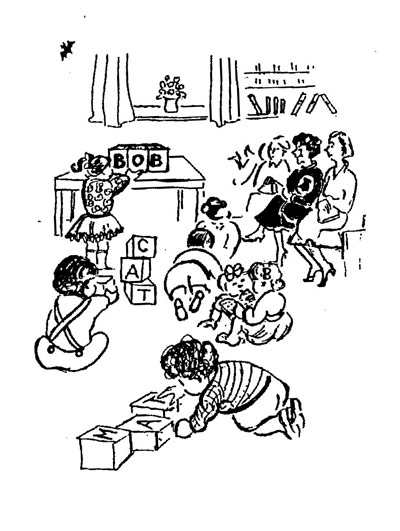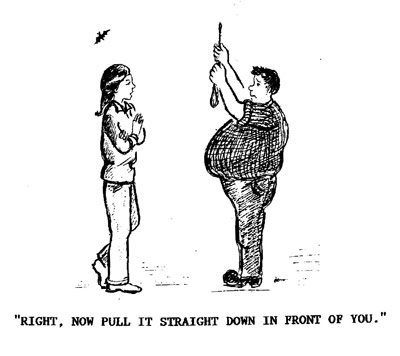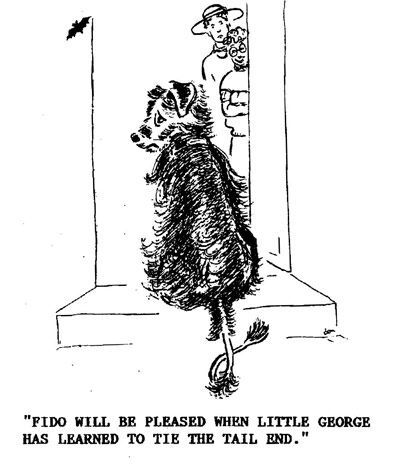Children and Adults Sometimes Learn Differently
by Wendy Graham
Of course, we are all human beings, with similar aspirations (to succeed!) and emotions, but we all change and develop (to a greater or lesser extent) as we age. The same “Golden Rules” apply to the teacher whether the pupil is a child or an adult but strengths and stresses vary and approaches and attitudes need to be treated differently by the teacher.
Children
Children are professional learners, so, not surprisingly, they are good at it. It’s what they do all day in school. Even those who think they are useless at school are still good learners. As learner ringers they do as they are told quickly and often without asking a lot of why and what if questions.
Most children are fearless, never imagining the bell could hurt them. Typically they will trust their teacher and happily take hold of any rope he or she suggests. What’s more, they generally have the confidence to ring the bell even if it is not as easy as at their home tower.
Children are members of a school class so they are used to learning when a group is present and watching, something which can be difficult for adults. They also tend to be less sensitive about the possibility of making fools of themselves. However, it is just as important that the teacher respects a child learner as an adult one. Children detest being patronised or ridiculed.
Children have very quick reactions. I remember watching my tower captain teaching a girl of about 9 to handle a bell. On this occasion he was trying to teach her how to catch the hand stroke while he controlled the back stroke. He told her to catch the sally when he said, “Now,” which, indeed, she did – often before he’d finished saying the word. She was catching it far too soon and it was a while before he had adjusted sufficiently to say, “Now,” at a suitable moment for her quick reactions.
My observation, which is confirmed by several experienced ringing teachers, is that those who learn before the age of about 20 develop excellent ropesight far quicker than older learners although I do not know any psychological reason why this should be so. Personally, I learned to ring (in my fifties) at the same time as 10 year old twin girls. It is not easy in a practice to fit three beginners in and one result of this was that, in the early days, the twins took turns on the treble while I always rang an inside bell. It is easier to see the order in which the bellropes fall from one end of the circle and younger, smaller ringers tend to spend more time ringing the treble. However, this is probably just my excuse. Young ringers are better at developing ropesight.
Everyone knows that it is important to encourage children and, quite likely, the whole band will make encouraging remarks to a child learner. This is excellent, especially when the young person is doing well. Praise increases motivation. Most people know that it is not helpful to praise what is not good as it does not help the learner to differentiate between good and mediocre. Usually, though, there is some detail which can justly be praised.
On the downside, children are less likely to be self-motivated than adult learners and, generally, become bored more easily. Motivation can be increased by setting targets. The target must be attainable but not too easy and, of course, the teacher must quite regularly let little Freddie demonstrate whether or not he can yet reach the current target; for instance, stand his bell 10 times in a row or ring a method on a different bell without any prompting. Once a target has been reached a new one must be set. It is even more motivating if Freddie helps choose his new target. The “One per Learner” books are helpful and the Bell Club Award Scheme even better in suggesting graduated targets and allowing the learner to keep a record. These are both Sherbourne Teaching Aids*, developed by Pam Copson in 1980s. They have proved invaluable to countless learners and every teacher should be familiar with them. “Learning the Ropes”* booklets, created by Pip Penney, to be used with the ITTS teacher training scheme, also work through graduated targets. If little Freddie, little Johnnie, little Laura and young Yolanda are all learning together there can be the added motivation of competition. Boys tend to be more competitive naturally than girls and cut-throat competition is not recommended but a good teacher will encourage a friendly competitive spirit. Most children will enjoy ringing more if they have friends of their own age in the group and, when possible, social activities, as well as ringing ones, should be organised for groups of young ringers. Pip Penney’s “Kids.Ring.Out” has been very successful in increasing enjoyment and, therefore, retention among young ringers in South Wales. In each school holiday a meeting for all 10-18 year olds across the area is arranged. It generally includes ringing at two towers, a pub lunch (during which ringing quiz sheets are filled in) and a “social” activity of the young people’s choice. This has ranged from water fights to “Go Ape” (organised high level adventure trails through woodland).
While a child’s brain often cannot cope with the more complicated methods until the age of 13 or 14, boredom from unrelieved doses of Call Changes and Plain Hunt is to be avoided at all costs. Get children to call the changes for the band and introduce variations, such as Kaleidoscope Ringing*, Mexican Wave, Dodgy Call Changes and unusual doubles methods. Pip Penney’s “Ringing Practice Toolkit”* can provide more details and ideas.
When all is going well, children generally learn in an even, upwards curve.
(For current Child Protection information see the CC Tower Stewardship Committee’s Guidance Note No. 3: Child Protection in Towers at: www.cccbr.org.uk/towerstewardship/notes/childprotection.pdf and Protecting Young Ringers at: www.cccbr.org.uk/towerstewardship/pubs/gdlnChildProtection.php )
Adults
Adult learners, however, tend to make less steady progress. It is more usual for an older person to have spurts of progress and then plateau for a while. It can be useful for a teacher to point this out to older learners who are feeling disillusioned because, in their eyes, they are not improving.
Adults can be difficult to teach. They can resent needing to take instruction and this feeling may be stronger if the student perceives the teacher as a youthful (albeit skilled) whipper-snapper. The majority of adults are relatively successful human beings. They know how to run a house, bring up children, drive a car, deal with finances and keep a job. They are used to telling others what to do and to take orders from someone else can seem demeaning. Paradoxically, some adults are aware they are being a mite surly with their teacher, while at the same time desperately wanting the teacher to help them progress. Some adult learners have high-powered occupations with enormous responsibilities and these, in fact, are the type of people most likely to take up challenges in later life but they are not always easy to teach. Many adults, performing their daily tasks to a high degree of efficiency, find it psychologically difficult to be a beginner, performing at a low level. So what can the teacher do with these Awkward Alecs? Be understanding, be patient, be tactful and be respectful.
Adult learners, unlike children, tend to ask question after question. “Why should I hold my hands like this, rather than like that?” “Why shouldn’t I look up?” etc. It is good that they want to understand the minutiae of ringing. Even if it can seem time wasting, the teacher must give explanations. Those who are used to being in control of their lives really need to know more about things that puzzle them.
As we mature into adults our awareness of danger increases – which, I assume, is why children are not permitted to drive cars. Adults can be nervous ringers. There is fear of pain and injury, for a start. Nervous Nancy has been taken to the belfry, has seen how big the bells are and has worked out that they range in weight from a washing machine to a medium-sized car. She has been told never to go near a bell that is up; it could kill her. She is all too aware of the huge, unwieldy object attached to the end of that innocent-looking rope. One false move, or so she imagines, and the bell and rope could go mad, taking the skin clean off her fingers or breaking them or pulling her at high speed into a collision with the ringing room ceiling. Up to a point, she is right to be more cautious than a young person would be as any injury will take longer to mend. Even a blister can take weeks to heal if the ringer is a septuagenarian and/or diabetic. Statistically, I believe, ringing is less dangerous than gardening. Nancy probably took a greater risk when she crossed the road to get to the church than she will be asked to take in the ringing room. Of course, by their nature, accidents do occasionally occur but, in a well run tower where ringing is taught carefully and properly, the teacher can reassure nervous beginners that serious injuries are rare and, so, help them to relax and be more receptive to learning. Everything carries some risk; if we didn’t accept that, none of us would ever get out of bed. Long ago, I told myself that, if a bell ever seemed likely to injure me, I’d just let go. The bell could probably look after itself and the other bits e.g. the stay, could be mended, if necessary. Nevertheless, a nervous ringer may well draw comfort from the teacher or another experienced ringer standing near by, long after he or she can actually handle a bell competently. Teachers should also be aware that arthritis or past injuries can make it impossible for some older learners to handle ropes in the classic style and should be ready to help them develop an efficient, alternative grip.
Another major, predominantly adult, fear is making a fool of oneself. It happens to us all from time to time. Missing the sally, for instance, can be embarrassing but, generally, in as short a time as an hour no-one will remember the incident, apart from the person who fumbled the sally. Another regular embarrassment is going wrong in a method which is well known to you. It is annoying, usually more so to the perpetrator than the other ringers, and caused most frequently by stressful situations and/or a lapse in concentration. Visiting other towers can lead to embarrassments, perhaps particularly because you are surrounded by strangers. A friend told me how, on a visit, she eagerly grabbed the treble when Plain Hunt was called. She could not understand how, after the first few strokes, everything seemed to go wrong. A fresh start was no improvement and she retired ignominiously. Only later did she realise that they were hunting on 6 bells (something she’d never heard of!) while she was trying to ring Plain Hunt on 5. A good teacher can help learners stay calm and reassure them that virtually all ringers have made the same embarrassing mistake at some time. Be philosophical. Most ringers are nice, understanding people.
Ringing is a corporate activity and adult learners often feel they’ll let the group down or hold them back from more exotic ringing. Of course, the learner must be sensitive and not grab a rope every time but no reasonable ringer minds helping beginners and we’ve all been there, even the real crack ringers. A thoughtful tower captain should make it clear to novices when it is their “turn” and when they should sit out. Once, on holiday, I was asked to take part in a quarter peal. I was unsure about this and told the organiser I might go wrong. She, a sensitive and gifted teacher, said, “Don’t worry. Take the opportunity. A quarter peal lost is no big deal.” I have always tried to remember that (especially when I have been the cause of losing a quarter!)
 Adults, unlike some children, are usually highly motivated. They will generally set their own targets, although the teacher may set some too. Targets may be useful “staging points” but, if the learner is self-motivated, targets will not increase this. Some learners are so keen to progress and succeed that, after a poor performance (in his or her eyes) in practice, and, while seeming cheerful in the tower, they will go home disillusioned and tearful. This is one reason why, ideally, a teacher or tower master should try to find a word of praise for every ringer, every practice. Knowing that something, even the smallest thing, was good (and pleased the teacher) can go a long way to restoring flagging self-esteem.
Adults, unlike some children, are usually highly motivated. They will generally set their own targets, although the teacher may set some too. Targets may be useful “staging points” but, if the learner is self-motivated, targets will not increase this. Some learners are so keen to progress and succeed that, after a poor performance (in his or her eyes) in practice, and, while seeming cheerful in the tower, they will go home disillusioned and tearful. This is one reason why, ideally, a teacher or tower master should try to find a word of praise for every ringer, every practice. Knowing that something, even the smallest thing, was good (and pleased the teacher) can go a long way to restoring flagging self-esteem.
I have met ringers who are reluctant to teach children on the grounds that they always give up (not to mention, they raise Health and Safety issues.) I understand, currently, around 90% of child learners do give up, although I know several ringers who learned as children, stopped, then took it up again in middle age. It is to be hoped that more awareness about teaching methods and learning, as well as generally understanding what children want, will lead to higher retention of young ringers. It is from this group that the majority of future peal ringers will come.
Innovation and pushing forward the boundaries of ringing will require some young blood. On the other hand, older learners are more likely to continue ringing. While few will become spectacular ringers, many will become stalwarts of their tower and it is this group who will keep church bells ringing, Sunday by Sunday. Any new, committed ringer just has to be a brilliant asset to the Exercise.
Cartoons reprinted from "Learning The Ropes", by kind permission of the author, Barbara Martin from Salisbury.
